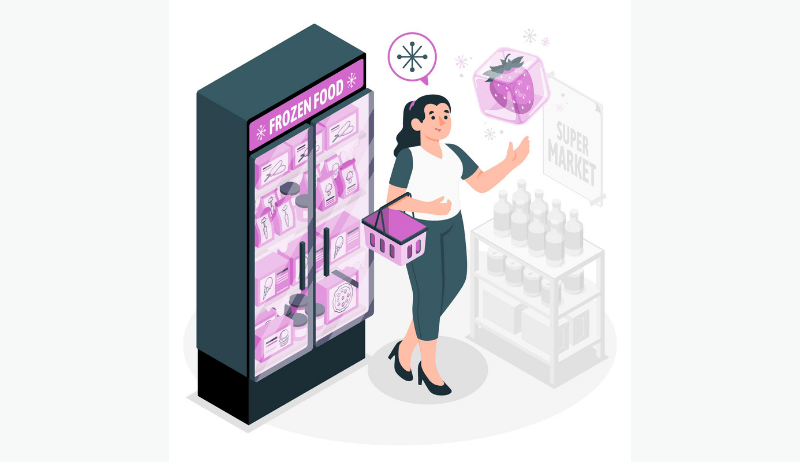Maintaining your commercial refrigerated display cabinet is crucial to ensure optimal performance and longevity. In New South Wales (NSW), where the demands of the commercial sector are high, it’s essential to follow effective maintenance tips to keep your refrigerated display cabinet in top condition. From cleaning drain pans and tubes to checking and cleaning the condenser and evaporator coils, every maintenance task plays a vital role in preserving the cabinet’s efficiency and the quality of your displayed products.
In this blog, we will explore valuable maintenance tips, safety precautions, frequently asked questions, and the importance of consulting professionals for maintaining your commercial refrigerated display cabinet in NSW. So, let’s dive in and discover how to keep your cabinet running smoothly and your products cool and fresh.
How To Maintain Your Refrigerated Display Cabinet
Cleanliness is Key
Temperature Control

Check and Replace Seals
Defrost Regularly
Monitor Energy Consumption
Regularly Inspect the Compressor
Air Ventilation
Monitor Humidity Levels

Train Staff on Proper Usage
Keep a Maintenance Log
Safety Tips and Tricks
- Always unplug the cabinet before performing any maintenance tasks to avoid electrical hazards.
- Use appropriate personal protective equipment (PPE) such as gloves and goggles when handling cleaning agents or performing maintenance activities.
- Be cautious when cleaning slippery surfaces inside the cabinet to prevent slips and falls. Use non-slip footwear and consider using a step stool or ladder if needed.
- Ensure that the electrical outlet used for the cabinet is properly grounded and can handle the power requirements.
- Regularly inspect the power cord for any damage or frayed wires. If you notice any issues, replace the cord immediately.
- Avoid overloading electrical outlets by plugging in additional appliances or extension cords. This can lead to overheating and electrical hazards.
- Store food products in appropriate packaging and containers to prevent cross-contamination and maintain hygiene.
- Regularly check the temperature of the food items in the cabinet to ensure they are within safe limits.
- If you notice any spoiled or expired food items, promptly remove them from the cabinet to prevent contamination.
- Keep flammable materials away from the cabinet to reduce the risk of fire. This includes paper, cardboard, and other combustible items.
- Install a fire extinguisher in close proximity to the cabinet and ensure it is regularly inspected and in working condition.
- Familiarize yourself and your staff with the location and proper use of fire safety equipment.

- If you need to handle refrigerants during maintenance or repairs, ensure you have the necessary certifications and training to do so safely.
- Follow proper guidelines for the storage, transportation, and disposal of refrigerants to prevent environmental damage and comply with regulations.
- Ensure that the area where the cabinet is placed has adequate ventilation to allow for proper airflow and prevent heat buildup.
- Regularly check the air quality in the vicinity of the cabinet. If you notice any unusual odors or signs of poor air quality, investigate and address the issue promptly.
- Develop an emergency response plan that includes protocols for power outages, equipment failures, and other potential emergencies.
- Train your staff on emergency procedures, including evacuation routes, emergency shut-off procedures, and contacting emergency services.
- Provide thorough training to your staff on the safe operation and maintenance of the refrigerated display cabinet.
- Educate them on the potential hazards associated with the cabinet and how to mitigate them.
- Encourage open communication so that any safety concerns can be promptly addressed.
Consult A Professional
Expert Knowledge and Experience:
Professional technicians have the necessary knowledge and experience to handle complex maintenance tasks related to commercial refrigerated display cabinets. They are trained to identify potential issues, troubleshoot problems, and perform thorough cleaning and maintenance procedures.
Specialized Tools and Equipment:
Professionals have access to specialized tools and equipment specifically designed for maintaining and cleaning refrigeration systems. These tools allow them to effectively clean coils, remove debris, and ensure optimal performance of the cabinet.
Preventing Damage:
Improper cleaning techniques or mishandling of components can potentially damage the condenser and evaporator coils. Professional technicians are skilled in performing maintenance tasks without causing any harm to the delicate parts of the cabinet.
Complying with Manufacturer’s Guidelines:
Each commercial refrigerated display cabinet may have specific maintenance requirements outlined by the manufacturer. Professional technicians are well-versed in these guidelines and ensure that the maintenance is performed in accordance with them, preserving any warranties or guarantees on the equipment.
Comprehensive Inspection:
When you consult a professional, they can conduct a thorough inspection of the cabinet beyond just cleaning the coils. They can identify any potential issues, such as refrigerant leaks, worn-out components, or malfunctioning parts. This allows for early detection and preventive measures to be taken, minimizing the risk of costly breakdowns or downtime.
Time and Convenience:
Engaging a professional technician for maintenance saves you time and effort. They can efficiently perform the necessary tasks, allowing you to focus on other aspects of your business. It also ensures that maintenance is done correctly and consistently, as professionals follow a systematic approach.
Don’t forget to schedule regular maintenance appointments with qualified professionals to ensure the ongoing performance and longevity of your commercial refrigerated display cabinet. They can provide expert advice, address any concerns, and help you maintain a safe and efficient cabinet that showcases your products effectively.








